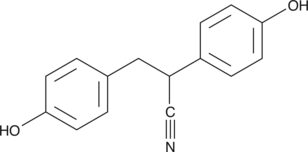Chemicals
Showing 4501–4650 of 41137 results
-
2-Phenethylamine is a natural monoamine alkaloid that acts as neuromodulator in the central nervous system. It stimulates the release of norepinephrine and dopamine and is metabolized by monoamine oxidases as well as other enzymes.{21276,26163,26162} This product is intended for forensic and research applications.
Brand:CaymanSKU:-2-Phenethylamine is a natural monoamine alkaloid that acts as neuromodulator in the central nervous system. It stimulates the release of norepinephrine and dopamine and is metabolized by monoamine oxidases as well as other enzymes.{21276,26163,26162} This product is intended for forensic and research applications.
Brand:CaymanSKU:-2-Phenyl-2-(1-piperidinyl)propane is an analog of phencyclidine that acts as a mechanism-based inactivator of human cytochrome P450 (CYP) 2B6 (Ki = 5.6 µM; IC50 = 5.1 µM).{29044} It is 15-fold more selective for inhibition of CYP2B6 over CYP2D6 and 40-60-fold more selective for CYP2B6 over CYP1A2, CYP2A6, CYP2Cs, and CYP3A.{29044}
Brand:CaymanSKU:-Available on backorder
2-Phenyl-2-(1-piperidinyl)propane is an analog of phencyclidine that acts as a mechanism-based inactivator of human cytochrome P450 (CYP) 2B6 (Ki = 5.6 µM; IC50 = 5.1 µM).{29044} It is 15-fold more selective for inhibition of CYP2B6 over CYP2D6 and 40-60-fold more selective for CYP2B6 over CYP1A2, CYP2A6, CYP2Cs, and CYP3A.{29044}
Brand:CaymanSKU:-Available on backorder
2-Phenyl-2-(1-piperidinyl)propane is an analog of phencyclidine that acts as a mechanism-based inactivator of human cytochrome P450 (CYP) 2B6 (Ki = 5.6 µM; IC50 = 5.1 µM).{29044} It is 15-fold more selective for inhibition of CYP2B6 over CYP2D6 and 40-60-fold more selective for CYP2B6 over CYP1A2, CYP2A6, CYP2Cs, and CYP3A.{29044}
Brand:CaymanSKU:-Available on backorder
2-Phenyl-2-(1-piperidinyl)propane is an analog of phencyclidine that acts as a mechanism-based inactivator of human cytochrome P450 (CYP) 2B6 (Ki = 5.6 µM; IC50 = 5.1 µM).{29044} It is 15-fold more selective for inhibition of CYP2B6 over CYP2D6 and 40-60-fold more selective for CYP2B6 over CYP1A2, CYP2A6, CYP2Cs, and CYP3A.{29044}
Brand:CaymanSKU:-Available on backorder
Brand:CaymanSKU:11057 - 1 gAvailable on backorder
Brand:CaymanSKU:11057 - 5 gAvailable on backorder
Brand:CaymanSKU:11057 - 500 mgAvailable on backorder
2-Phenylaminoadenosine is an adenosine receptor agonist.{48560} It binds to adenosine A1 receptors in rat cortical membranes (IC50 = 910 nM) and A2 receptors in rat striatal membranes (IC50 = 115 nM). 2-Phenylaminoadenosine increases coronary flow in a perfused working rat heart model ex vivo (EC25 = 110 nM). It decreases blood pressure in normotensive (ED25 = 28 μg/kg) and spontaneously hypertensive rats (SHR; ED30 = 5.32 μg/kg).{48560,48561} 2-Phenylaminoadenosine (500 nmol/kg) increases L-dihydroxyphenylalanine (L-DOPA; Item No. 13248) accumulation in rat striatum.{48562} It also inhibits conditioned avoidance responding (CAR) to electric shock in rats (ED50 = 1.3 mg/kg).{48563}
Brand:CaymanSKU:28734 - 10 mgAvailable on backorder
2-Phenylaminoadenosine is an adenosine receptor agonist.{48560} It binds to adenosine A1 receptors in rat cortical membranes (IC50 = 910 nM) and A2 receptors in rat striatal membranes (IC50 = 115 nM). 2-Phenylaminoadenosine increases coronary flow in a perfused working rat heart model ex vivo (EC25 = 110 nM). It decreases blood pressure in normotensive (ED25 = 28 μg/kg) and spontaneously hypertensive rats (SHR; ED30 = 5.32 μg/kg).{48560,48561} 2-Phenylaminoadenosine (500 nmol/kg) increases L-dihydroxyphenylalanine (L-DOPA; Item No. 13248) accumulation in rat striatum.{48562} It also inhibits conditioned avoidance responding (CAR) to electric shock in rats (ED50 = 1.3 mg/kg).{48563}
Brand:CaymanSKU:28734 - 25 mgAvailable on backorder
2-Phenylaminoadenosine is an adenosine receptor agonist.{48560} It binds to adenosine A1 receptors in rat cortical membranes (IC50 = 910 nM) and A2 receptors in rat striatal membranes (IC50 = 115 nM). 2-Phenylaminoadenosine increases coronary flow in a perfused working rat heart model ex vivo (EC25 = 110 nM). It decreases blood pressure in normotensive (ED25 = 28 μg/kg) and spontaneously hypertensive rats (SHR; ED30 = 5.32 μg/kg).{48560,48561} 2-Phenylaminoadenosine (500 nmol/kg) increases L-dihydroxyphenylalanine (L-DOPA; Item No. 13248) accumulation in rat striatum.{48562} It also inhibits conditioned avoidance responding (CAR) to electric shock in rats (ED50 = 1.3 mg/kg).{48563}
Brand:CaymanSKU:28734 - 5 mgAvailable on backorder
2-Phenylaminoadenosine is an adenosine receptor agonist.{48560} It binds to adenosine A1 receptors in rat cortical membranes (IC50 = 910 nM) and A2 receptors in rat striatal membranes (IC50 = 115 nM). 2-Phenylaminoadenosine increases coronary flow in a perfused working rat heart model ex vivo (EC25 = 110 nM). It decreases blood pressure in normotensive (ED25 = 28 μg/kg) and spontaneously hypertensive rats (SHR; ED30 = 5.32 μg/kg).{48560,48561} 2-Phenylaminoadenosine (500 nmol/kg) increases L-dihydroxyphenylalanine (L-DOPA; Item No. 13248) accumulation in rat striatum.{48562} It also inhibits conditioned avoidance responding (CAR) to electric shock in rats (ED50 = 1.3 mg/kg).{48563}
Brand:CaymanSKU:28734 - 50 mgAvailable on backorder
2-PMAP is an inhibitor of the production of amyloid precursor protein (APP) and amyloid-β (Aβ) secretion.{48316} It reduces levels of APP and its intracellular C-terminal fragments α-CTF and β-CTF in CHO APP751SW cells when used at a concentration of 10 μM. 2-PMAP also reduces secretion of Aβ (1-40) and Aβ (1-42) by 88.6 and 84.9%, respectively, in CHO APP751SW cells when used at a concentration of 50 μM without inducing cellular toxicity. In vivo, 2-PMAP reduces brain levels of full-length APP, α-CTF and β-CTF, and soluble Aβ (1-40) and Aβ (1-42) in the APPSWPS1dE9 transgenic mouse model of Alzheimer’s disease. It also improves novel object memory as well as spatial memory in the radial arm maze in APPSWPS1dE9 transgenic mice.
Brand:CaymanSKU:21021 -Out of stock
2-PMAP is an inhibitor of the production of amyloid precursor protein (APP) and amyloid-β (Aβ) secretion.{48316} It reduces levels of APP and its intracellular C-terminal fragments α-CTF and β-CTF in CHO APP751SW cells when used at a concentration of 10 μM. 2-PMAP also reduces secretion of Aβ (1-40) and Aβ (1-42) by 88.6 and 84.9%, respectively, in CHO APP751SW cells when used at a concentration of 50 μM without inducing cellular toxicity. In vivo, 2-PMAP reduces brain levels of full-length APP, α-CTF and β-CTF, and soluble Aβ (1-40) and Aβ (1-42) in the APPSWPS1dE9 transgenic mouse model of Alzheimer’s disease. It also improves novel object memory as well as spatial memory in the radial arm maze in APPSWPS1dE9 transgenic mice.
Brand:CaymanSKU:21021 -Out of stock
2-PMAP is an inhibitor of the production of amyloid precursor protein (APP) and amyloid-β (Aβ) secretion.{48316} It reduces levels of APP and its intracellular C-terminal fragments α-CTF and β-CTF in CHO APP751SW cells when used at a concentration of 10 μM. 2-PMAP also reduces secretion of Aβ (1-40) and Aβ (1-42) by 88.6 and 84.9%, respectively, in CHO APP751SW cells when used at a concentration of 50 μM without inducing cellular toxicity. In vivo, 2-PMAP reduces brain levels of full-length APP, α-CTF and β-CTF, and soluble Aβ (1-40) and Aβ (1-42) in the APPSWPS1dE9 transgenic mouse model of Alzheimer’s disease. It also improves novel object memory as well as spatial memory in the radial arm maze in APPSWPS1dE9 transgenic mice.
Brand:CaymanSKU:21021 -Out of stock
2-PMAP is an inhibitor of the production of amyloid precursor protein (APP) and amyloid-β (Aβ) secretion.{48316} It reduces levels of APP and its intracellular C-terminal fragments α-CTF and β-CTF in CHO APP751SW cells when used at a concentration of 10 μM. 2-PMAP also reduces secretion of Aβ (1-40) and Aβ (1-42) by 88.6 and 84.9%, respectively, in CHO APP751SW cells when used at a concentration of 50 μM without inducing cellular toxicity. In vivo, 2-PMAP reduces brain levels of full-length APP, α-CTF and β-CTF, and soluble Aβ (1-40) and Aβ (1-42) in the APPSWPS1dE9 transgenic mouse model of Alzheimer’s disease. It also improves novel object memory as well as spatial memory in the radial arm maze in APPSWPS1dE9 transgenic mice.
Brand:CaymanSKU:21021 -Out of stock
Brand:CaymanSKU:13003 - 1 gAvailable on backorder
Brand:CaymanSKU:13003 - 100 mgAvailable on backorder
Brand:CaymanSKU:13003 - 250 mgAvailable on backorder
Brand:CaymanSKU:13003 - 500 mgAvailable on backorder
Brand:CaymanSKU:13043 - 1 gAvailable on backorder
Brand:CaymanSKU:13043 - 10 gAvailable on backorder
Brand:CaymanSKU:13043 - 25 gAvailable on backorder
Brand:CaymanSKU:13043 - 5 gAvailable on backorder
Brand:CaymanSKU:10007108 - 1 gAvailable on backorder
Brand:CaymanSKU:10007108 - 100 mgAvailable on backorder
Brand:CaymanSKU:10007108 - 500 mgAvailable on backorder
Brand:CaymanSKU:10007116 - 1 gAvailable on backorder
Brand:CaymanSKU:10007116 - 100 mgAvailable on backorder
Brand:CaymanSKU:10007116 - 500 mgAvailable on backorder
2-Stearoyl-rac-glycerol is a monoacylglycerol containing stearic acid (Item No. 10011298) at the sn-2 position. 2-Stearoyl-rac-glycerol levels are increased in mouse plasma following exposure to low-dose ionizing radiation, as well as in rat kidney in a model of ischemia-reperfusion injury.{42678,42679}
Brand:CaymanSKU:27282 - 10 mgAvailable on backorder
2-Stearoyl-rac-glycerol is a monoacylglycerol containing stearic acid (Item No. 10011298) at the sn-2 position. 2-Stearoyl-rac-glycerol levels are increased in mouse plasma following exposure to low-dose ionizing radiation, as well as in rat kidney in a model of ischemia-reperfusion injury.{42678,42679}
Brand:CaymanSKU:27282 - 25 mgAvailable on backorder
2-Stearoyl-rac-glycerol is a monoacylglycerol containing stearic acid (Item No. 10011298) at the sn-2 position. 2-Stearoyl-rac-glycerol levels are increased in mouse plasma following exposure to low-dose ionizing radiation, as well as in rat kidney in a model of ischemia-reperfusion injury.{42678,42679}
Brand:CaymanSKU:27282 - 5 mgAvailable on backorder
2-Thenoyltrifluoroacetone (TTFA) is an inhibitor of respiration in animals and bacteria. In animals, TTFA binds at the quinone reduction site of succinate:ubiquinone oxidoreductase (SQR; Complex II), preventing ubiquinone from binding.{29181,21747} It inhibits NADH fumarate reductase in bacteria.{29182,29179} TTFA also inhibits photosystem II in plants and NADH-ubiquinone oxidoreductase of the virus Vibrio cholerae, decreasing cholera toxin production.{24939,29180} This compound is also a chelator of metals, including lanthanum, zirconium, hafnium, and neodymium.
Brand:CaymanSKU:-2-Thenoyltrifluoroacetone (TTFA) is an inhibitor of respiration in animals and bacteria. In animals, TTFA binds at the quinone reduction site of succinate:ubiquinone oxidoreductase (SQR; Complex II), preventing ubiquinone from binding.{29181,21747} It inhibits NADH fumarate reductase in bacteria.{29182,29179} TTFA also inhibits photosystem II in plants and NADH-ubiquinone oxidoreductase of the virus Vibrio cholerae, decreasing cholera toxin production.{24939,29180} This compound is also a chelator of metals, including lanthanum, zirconium, hafnium, and neodymium.
Brand:CaymanSKU:-2-Thenoyltrifluoroacetone (TTFA) is an inhibitor of respiration in animals and bacteria. In animals, TTFA binds at the quinone reduction site of succinate:ubiquinone oxidoreductase (SQR; Complex II), preventing ubiquinone from binding.{29181,21747} It inhibits NADH fumarate reductase in bacteria.{29182,29179} TTFA also inhibits photosystem II in plants and NADH-ubiquinone oxidoreductase of the virus Vibrio cholerae, decreasing cholera toxin production.{24939,29180} This compound is also a chelator of metals, including lanthanum, zirconium, hafnium, and neodymium.
Brand:CaymanSKU:-2-Thenoyltrifluoroacetone (TTFA) is an inhibitor of respiration in animals and bacteria. In animals, TTFA binds at the quinone reduction site of succinate:ubiquinone oxidoreductase (SQR; Complex II), preventing ubiquinone from binding.{29181,21747} It inhibits NADH fumarate reductase in bacteria.{29182,29179} TTFA also inhibits photosystem II in plants and NADH-ubiquinone oxidoreductase of the virus Vibrio cholerae, decreasing cholera toxin production.{24939,29180} This compound is also a chelator of metals, including lanthanum, zirconium, hafnium, and neodymium.
Brand:CaymanSKU:-KIAA1363 is a recently characterized 2-acetyl monoacylglyceryl ether hydrolase that is critical to the survival and proliferation of many cancer cell lines.{14603} 2-thioacetyl MAGE is a colorimetric substrate for KIAA1363. It can readily be adapted to perform activity/inhibition studies of this new enzyme, using standard DTNB detection of the free thiol as a readout for enzymatic activity.{14603}
Brand:CaymanSKU:10009651 - 1 mgAvailable on backorder
KIAA1363 is a recently characterized 2-acetyl monoacylglyceryl ether hydrolase that is critical to the survival and proliferation of many cancer cell lines.{14603} 2-thioacetyl MAGE is a colorimetric substrate for KIAA1363. It can readily be adapted to perform activity/inhibition studies of this new enzyme, using standard DTNB detection of the free thiol as a readout for enzymatic activity.{14603}
Brand:CaymanSKU:10009651 - 10 mgAvailable on backorder
KIAA1363 is a recently characterized 2-acetyl monoacylglyceryl ether hydrolase that is critical to the survival and proliferation of many cancer cell lines.{14603} 2-thioacetyl MAGE is a colorimetric substrate for KIAA1363. It can readily be adapted to perform activity/inhibition studies of this new enzyme, using standard DTNB detection of the free thiol as a readout for enzymatic activity.{14603}
Brand:CaymanSKU:10009651 - 25 mgAvailable on backorder
KIAA1363 is a recently characterized 2-acetyl monoacylglyceryl ether hydrolase that is critical to the survival and proliferation of many cancer cell lines.{14603} 2-thioacetyl MAGE is a colorimetric substrate for KIAA1363. It can readily be adapted to perform activity/inhibition studies of this new enzyme, using standard DTNB detection of the free thiol as a readout for enzymatic activity.{14603}
Brand:CaymanSKU:10009651 - 5 mgAvailable on backorder
2-thio PAF is an isosteric analog of PAF. It is also a synthetic analog of PAF which contains an acetyl group attached by a thioester bond at the sn-2 position. It functions as a PAF receptor agonist, and its potency is comparable to PAF C-18 in rabbit platelet aggregation, and to PAF C-16 in the activation of guinea pig macrophages.{3786} 2-thio PAF is a substrate for lysophospholipase II and for PAF-AH,{3787} and is the substrate used in Cayman’s PAF-AH Assay Kit (Item No. 760901).
Brand:CaymanSKU:60945 - 10 mgAvailable on backorder
2-thio PAF is an isosteric analog of PAF. It is also a synthetic analog of PAF which contains an acetyl group attached by a thioester bond at the sn-2 position. It functions as a PAF receptor agonist, and its potency is comparable to PAF C-18 in rabbit platelet aggregation, and to PAF C-16 in the activation of guinea pig macrophages.{3786} 2-thio PAF is a substrate for lysophospholipase II and for PAF-AH,{3787} and is the substrate used in Cayman’s PAF-AH Assay Kit (Item No. 760901).
Brand:CaymanSKU:60945 - 25 mgAvailable on backorder
2-thio PAF is an isosteric analog of PAF. It is also a synthetic analog of PAF which contains an acetyl group attached by a thioester bond at the sn-2 position. It functions as a PAF receptor agonist, and its potency is comparable to PAF C-18 in rabbit platelet aggregation, and to PAF C-16 in the activation of guinea pig macrophages.{3786} 2-thio PAF is a substrate for lysophospholipase II and for PAF-AH,{3787} and is the substrate used in Cayman’s PAF-AH Assay Kit (Item No. 760901).
Brand:CaymanSKU:60945 - 5 mgAvailable on backorder
2-thio PAF is an isosteric analog of PAF. It is also a synthetic analog of PAF which contains an acetyl group attached by a thioester bond at the sn-2 position. It functions as a PAF receptor agonist, and its potency is comparable to PAF C-18 in rabbit platelet aggregation, and to PAF C-16 in the activation of guinea pig macrophages.{3786} 2-thio PAF is a substrate for lysophospholipase II and for PAF-AH,{3787} and is the substrate used in Cayman’s PAF-AH Assay Kit (Item No. 760901).
Brand:CaymanSKU:60945 - 50 mgAvailable on backorder
2-Thiobarbituric acid is a colorimetric reagent commonly used in the detection of malondialdehyde (MDA), a marker of lipid peroxidation.{51012,51013} 2-Thiobarbituric acid forms a complex with MDA that can be quantified by colorimetric detection at 532 nm as a measure of lipid peroxidation.
Brand:CaymanSKU:27367 - 100 gAvailable on backorder
2-Thiobarbituric acid is a colorimetric reagent commonly used in the detection of malondialdehyde (MDA), a marker of lipid peroxidation.{51012,51013} 2-Thiobarbituric acid forms a complex with MDA that can be quantified by colorimetric detection at 532 nm as a measure of lipid peroxidation.
Brand:CaymanSKU:27367 - 25 gAvailable on backorder
2-Thiobarbituric acid is a colorimetric reagent commonly used in the detection of malondialdehyde (MDA), a marker of lipid peroxidation.{51012,51013} 2-Thiobarbituric acid forms a complex with MDA that can be quantified by colorimetric detection at 532 nm as a measure of lipid peroxidation.
Brand:CaymanSKU:27367 - 250 gAvailable on backorder
2-Thiobarbituric acid is a colorimetric reagent commonly used in the detection of malondialdehyde (MDA), a marker of lipid peroxidation.{51012,51013} 2-Thiobarbituric acid forms a complex with MDA that can be quantified by colorimetric detection at 532 nm as a measure of lipid peroxidation.
Brand:CaymanSKU:27367 - 50 gAvailable on backorder
2-Thiothinone is an analog of methcathinone (Item No. 11709) in which the phenyl group is replaced with a thiophene group. The physiological and toxicological properties of this compound are not known. This product is intended for forensic and research applications.
Brand:CaymanSKU:9002101 - 1 mgAvailable on backorder
2-Thiothinone is an analog of methcathinone (Item No. 11709) in which the phenyl group is replaced with a thiophene group. The physiological and toxicological properties of this compound are not known. This product is intended for forensic and research applications.
Brand:CaymanSKU:9002101 - 10 mgAvailable on backorder
2-Thiothinone is an analog of methcathinone (Item No. 11709) in which the phenyl group is replaced with a thiophene group. The physiological and toxicological properties of this compound are not known. This product is intended for forensic and research applications.
Brand:CaymanSKU:9002101 - 5 mgAvailable on backorder
2-Thiouridine (s2U) is a modified nucleobase found in tRNAs that is known to stabilize U:A pairs and modestly destabilize U:G wobble pairs.{33086,33087,33088} Modified nucleobases, including 2-thiouridine, are used to study nucleic acid structure and function as well as to engineer novel RNA-based biomolecules.
Brand:CaymanSKU:21011 -Out of stock
2-Thiouridine (s2U) is a modified nucleobase found in tRNAs that is known to stabilize U:A pairs and modestly destabilize U:G wobble pairs.{33086,33087,33088} Modified nucleobases, including 2-thiouridine, are used to study nucleic acid structure and function as well as to engineer novel RNA-based biomolecules.
Brand:CaymanSKU:21011 -Out of stock
2-Thiouridine (s2U) is a modified nucleobase found in tRNAs that is known to stabilize U:A pairs and modestly destabilize U:G wobble pairs.{33086,33087,33088} Modified nucleobases, including 2-thiouridine, are used to study nucleic acid structure and function as well as to engineer novel RNA-based biomolecules.
Brand:CaymanSKU:21011 -Out of stock
2-Thiouridine (s2U) is a modified nucleobase found in tRNAs that is known to stabilize U:A pairs and modestly destabilize U:G wobble pairs.{33086,33087,33088} Modified nucleobases, including 2-thiouridine, are used to study nucleic acid structure and function as well as to engineer novel RNA-based biomolecules.
Brand:CaymanSKU:21011 -Out of stock
Nrf2 activation is central to cytoprotective gene expression against oxidative and/or electrophilic stress.{17702} Unless activated by inflammatory, environmental, or oxidative stressors, Nrf2 is sequestered in the cytoplasm by its repressor, Keap1.{16386} Because of its protective capabilities, small molecules that activate Nrf2 signaling are being examined as potential anti-cancer or anti-inflammatory agents.{20661} 2-Trifluoromethyl-2′-methoxychalcone is a potent activator of Nrf2, both in vitro and in mice.{21374} Human bronchial epithelial cells treated with 10 μM 2-trifluoromethyl-2′-methoxychalcone showed a marked increase in the expression of the Nrf2-regulated antioxidant genes, GCLM and NQO1. Furthermore, treatment of mice mice with 50 mg/kg 2-trifluoromethyl-2’-methoxychalcone leads to a 4.5- and 4.6-fold increase in the expression of GCLM and NQO1, respectively, in the small intestine compared to controls.{21374}
Brand:CaymanSKU:11881 - 10 mgAvailable on backorder
Nrf2 activation is central to cytoprotective gene expression against oxidative and/or electrophilic stress.{17702} Unless activated by inflammatory, environmental, or oxidative stressors, Nrf2 is sequestered in the cytoplasm by its repressor, Keap1.{16386} Because of its protective capabilities, small molecules that activate Nrf2 signaling are being examined as potential anti-cancer or anti-inflammatory agents.{20661} 2-Trifluoromethyl-2′-methoxychalcone is a potent activator of Nrf2, both in vitro and in mice.{21374} Human bronchial epithelial cells treated with 10 μM 2-trifluoromethyl-2′-methoxychalcone showed a marked increase in the expression of the Nrf2-regulated antioxidant genes, GCLM and NQO1. Furthermore, treatment of mice mice with 50 mg/kg 2-trifluoromethyl-2’-methoxychalcone leads to a 4.5- and 4.6-fold increase in the expression of GCLM and NQO1, respectively, in the small intestine compared to controls.{21374}
Brand:CaymanSKU:11881 - 100 mgAvailable on backorder
Nrf2 activation is central to cytoprotective gene expression against oxidative and/or electrophilic stress.{17702} Unless activated by inflammatory, environmental, or oxidative stressors, Nrf2 is sequestered in the cytoplasm by its repressor, Keap1.{16386} Because of its protective capabilities, small molecules that activate Nrf2 signaling are being examined as potential anti-cancer or anti-inflammatory agents.{20661} 2-Trifluoromethyl-2′-methoxychalcone is a potent activator of Nrf2, both in vitro and in mice.{21374} Human bronchial epithelial cells treated with 10 μM 2-trifluoromethyl-2′-methoxychalcone showed a marked increase in the expression of the Nrf2-regulated antioxidant genes, GCLM and NQO1. Furthermore, treatment of mice mice with 50 mg/kg 2-trifluoromethyl-2’-methoxychalcone leads to a 4.5- and 4.6-fold increase in the expression of GCLM and NQO1, respectively, in the small intestine compared to controls.{21374}
Brand:CaymanSKU:11881 - 5 mgAvailable on backorder
Nrf2 activation is central to cytoprotective gene expression against oxidative and/or electrophilic stress.{17702} Unless activated by inflammatory, environmental, or oxidative stressors, Nrf2 is sequestered in the cytoplasm by its repressor, Keap1.{16386} Because of its protective capabilities, small molecules that activate Nrf2 signaling are being examined as potential anti-cancer or anti-inflammatory agents.{20661} 2-Trifluoromethyl-2′-methoxychalcone is a potent activator of Nrf2, both in vitro and in mice.{21374} Human bronchial epithelial cells treated with 10 μM 2-trifluoromethyl-2′-methoxychalcone showed a marked increase in the expression of the Nrf2-regulated antioxidant genes, GCLM and NQO1. Furthermore, treatment of mice mice with 50 mg/kg 2-trifluoromethyl-2’-methoxychalcone leads to a 4.5- and 4.6-fold increase in the expression of GCLM and NQO1, respectively, in the small intestine compared to controls.{21374}
Brand:CaymanSKU:11881 - 50 mgAvailable on backorder
2,2′-Bipyridine-5,5′-dicarboxylic acid is a heterocyclic building block.{49474,49475} It has been used in the synthesis of metal-organic frameworks for water oxidation, organic photocatalysis, and carbon dioxide reduction.
Brand:CaymanSKU:29472 - 1 gAvailable on backorder
2,2′-Bipyridine-5,5′-dicarboxylic acid is a heterocyclic building block.{49474,49475} It has been used in the synthesis of metal-organic frameworks for water oxidation, organic photocatalysis, and carbon dioxide reduction.
Brand:CaymanSKU:29472 - 10 gAvailable on backorder
2,2′-Bipyridine-5,5′-dicarboxylic acid is a heterocyclic building block.{49474,49475} It has been used in the synthesis of metal-organic frameworks for water oxidation, organic photocatalysis, and carbon dioxide reduction.
Brand:CaymanSKU:29472 - 5 gAvailable on backorder
2,2’-Biquinoline-4,4’-dicarboxylic acid (BCA) is a colorimetric reagent for the detection of copper (Cu+).{43857,54164} BCA and Cu+ form a stable 2:1 complex that has an absorbance maximum at 562 nm.{43857} It is commonly used as a reagent in the colorimetric BCA protein quantitation assay in which Cu2+ is converted to Cu+ as a function of protein concentration under alkaline conditions.{43857,54165}
Brand:CaymanSKU:30425 - 1 gAvailable on backorder
2,2’-Biquinoline-4,4’-dicarboxylic acid (BCA) is a colorimetric reagent for the detection of copper (Cu+).{43857,54164} BCA and Cu+ form a stable 2:1 complex that has an absorbance maximum at 562 nm.{43857} It is commonly used as a reagent in the colorimetric BCA protein quantitation assay in which Cu2+ is converted to Cu+ as a function of protein concentration under alkaline conditions.{43857,54165}
Brand:CaymanSKU:30425 - 5 gAvailable on backorder
2,3-bis(4-Hydroxyphenyl)propionitrile (DPN) is an estrogen receptor β (ERβ) selective agonist. DPN exhibits a 70-fold higher relative binding affinity for ERβ (18%) versus ERα (0.25%), about 80-fold higher transcriptional potency (EC50 = 0.85 nM versus 66 nM), and 170-fold higher relative potency (4.6% versus 0.025%) in transcription assays.{14165} Based on this selectivity, DPN is commonly used as a tool to evaluate the biological role of ERβ.
Brand:CaymanSKU:10008842 - 10 mgAvailable on backorder
2,3-bis(4-Hydroxyphenyl)propionitrile (DPN) is an estrogen receptor β (ERβ) selective agonist. DPN exhibits a 70-fold higher relative binding affinity for ERβ (18%) versus ERα (0.25%), about 80-fold higher transcriptional potency (EC50 = 0.85 nM versus 66 nM), and 170-fold higher relative potency (4.6% versus 0.025%) in transcription assays.{14165} Based on this selectivity, DPN is commonly used as a tool to evaluate the biological role of ERβ.
Brand:CaymanSKU:10008842 - 100 mgAvailable on backorder
2,3-bis(4-Hydroxyphenyl)propionitrile (DPN) is an estrogen receptor β (ERβ) selective agonist. DPN exhibits a 70-fold higher relative binding affinity for ERβ (18%) versus ERα (0.25%), about 80-fold higher transcriptional potency (EC50 = 0.85 nM versus 66 nM), and 170-fold higher relative potency (4.6% versus 0.025%) in transcription assays.{14165} Based on this selectivity, DPN is commonly used as a tool to evaluate the biological role of ERβ.
Brand:CaymanSKU:10008842 - 5 mgAvailable on backorder
2,3-bis(4-Hydroxyphenyl)propionitrile (DPN) is an estrogen receptor β (ERβ) selective agonist. DPN exhibits a 70-fold higher relative binding affinity for ERβ (18%) versus ERα (0.25%), about 80-fold higher transcriptional potency (EC50 = 0.85 nM versus 66 nM), and 170-fold higher relative potency (4.6% versus 0.025%) in transcription assays.{14165} Based on this selectivity, DPN is commonly used as a tool to evaluate the biological role of ERβ.
Brand:CaymanSKU:10008842 - 50 mgAvailable on backorder
2,3-Butanedione-2-monoxime (BDM) is a non-selective, reversible myosin ATPase inhibitor with phosphatase-like properties.{32613,32612} It demonstrates direct and indirect actions on cardiac and vascular smooth muscle, inhibiting L-type Ca2+ channels.{32611,23724} BDM has been shown to be involved in a number of biological activities, including muscle contraction and synaptic transmission.{32613}
Brand:CaymanSKU:20828 -Out of stock
2,3-Butanedione-2-monoxime (BDM) is a non-selective, reversible myosin ATPase inhibitor with phosphatase-like properties.{32613,32612} It demonstrates direct and indirect actions on cardiac and vascular smooth muscle, inhibiting L-type Ca2+ channels.{32611,23724} BDM has been shown to be involved in a number of biological activities, including muscle contraction and synaptic transmission.{32613}
Brand:CaymanSKU:20828 -Out of stock
2,3-Butanedione-2-monoxime (BDM) is a non-selective, reversible myosin ATPase inhibitor with phosphatase-like properties.{32613,32612} It demonstrates direct and indirect actions on cardiac and vascular smooth muscle, inhibiting L-type Ca2+ channels.{32611,23724} BDM has been shown to be involved in a number of biological activities, including muscle contraction and synaptic transmission.{32613}
Brand:CaymanSKU:20828 -Out of stock
2,3-Butanedione-2-monoxime (BDM) is a non-selective, reversible myosin ATPase inhibitor with phosphatase-like properties.{32613,32612} It demonstrates direct and indirect actions on cardiac and vascular smooth muscle, inhibiting L-type Ca2+ channels.{32611,23724} BDM has been shown to be involved in a number of biological activities, including muscle contraction and synaptic transmission.{32613}
Brand:CaymanSKU:20828 -Out of stock
2,3-DCPE is a proapoptotic compound with selectivity for cancer cells versus normal human cells. It induces apoptosis in vitro in various cancer cell lines (IC50s = 0.89-2.69 µM) more effectively than in normal human fibroblasts (IC50 = 12.6 µM). 2,3-DCPE down-regulates Bcl-xL, however forced overexpression of Bcl-xL is sufficient to block 2,3-DCPE apoptosis induction.{11853} 2,3-DCPE can induce S-phase arrest, upregulate p21, and activate ERK.{14281}
Brand:CaymanSKU:10005229 - 10 mgAvailable on backorder
2,3-DCPE is a proapoptotic compound with selectivity for cancer cells versus normal human cells. It induces apoptosis in vitro in various cancer cell lines (IC50s = 0.89-2.69 µM) more effectively than in normal human fibroblasts (IC50 = 12.6 µM). 2,3-DCPE down-regulates Bcl-xL, however forced overexpression of Bcl-xL is sufficient to block 2,3-DCPE apoptosis induction.{11853} 2,3-DCPE can induce S-phase arrest, upregulate p21, and activate ERK.{14281}
Brand:CaymanSKU:10005229 - 5 mgAvailable on backorder
2,3-DCPE is a proapoptotic compound with selectivity for cancer cells versus normal human cells. It induces apoptosis in vitro in various cancer cell lines (IC50s = 0.89-2.69 µM) more effectively than in normal human fibroblasts (IC50 = 12.6 µM). 2,3-DCPE down-regulates Bcl-xL, however forced overexpression of Bcl-xL is sufficient to block 2,3-DCPE apoptosis induction.{11853} 2,3-DCPE can induce S-phase arrest, upregulate p21, and activate ERK.{14281}
Brand:CaymanSKU:10005229 - 50 mgAvailable on backorder
2,3-Dichlorophenylpiperazine is an analog of 3-chlorophenylpiperazine, a psychoactive drug of abuse.{20497,21515,19874} The physiological and toxicological properties of this analog have not been evaluated. This product is intended for forensic and research purposes.
Brand:CaymanSKU:-2,3-Dichlorophenylpiperazine is an analog of 3-chlorophenylpiperazine, a psychoactive drug of abuse.{20497,21515,19874} The physiological and toxicological properties of this analog have not been evaluated. This product is intended for forensic and research purposes.
Brand:CaymanSKU:-2,3-Dichlorophenylpiperazine is an analog of 3-chlorophenylpiperazine, a psychoactive drug of abuse.{20497,21515,19874} The physiological and toxicological properties of this analog have not been evaluated. This product is intended for forensic and research purposes.
Brand:CaymanSKU:-1,2,3-Thiadiazoles have diverse applications in medicine and agriculture, such as bactericides, fungicides, and antiviral agents. 2,3-dihydrothieno-Thiadiazole carboxylate (MTCC), 100 µM, both inhibits and inactivates certain microsomal CYP450 enzymes (CYP2E1 and CYP2B4), but not others (CYP1A2), with inactivation occurring in a mechanism-based manner.{15950}
Brand:CaymanSKU:10011048 - 10 mgAvailable on backorder























